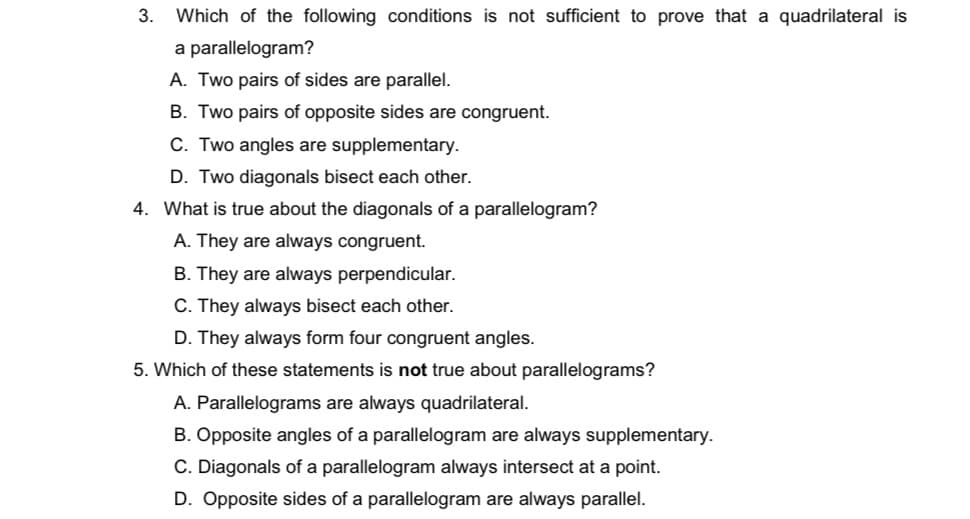Which of the following conditions is not sufficient to prove that a quadrilateral is a parallelogram? A. Two pairs of sides are parallel. B. Two pairs of opposite sides are congruent. C. Two angles are supplementary. D. Two diagonals bisect each other. 4. What is true about the diagonals of a parallelogram? A. They are always congruent. B. They are always perpendicular. C. They always bisect each other. D. They always form four congruent angles. 5. Which of these statements is not true about parallelograms? A. Parallelograms are always quadrilateral. B. Opposite angles of a parallelogram are always supplementary. C. Diagonals of a parallelogram always intersect at a point. D. Opposite sides of a parallelogram are always parallel. 3.
Which of the following conditions is not sufficient to prove that a quadrilateral is a parallelogram? A. Two pairs of sides are parallel. B. Two pairs of opposite sides are congruent. C. Two angles are supplementary. D. Two diagonals bisect each other. 4. What is true about the diagonals of a parallelogram? A. They are always congruent. B. They are always perpendicular. C. They always bisect each other. D. They always form four congruent angles. 5. Which of these statements is not true about parallelograms? A. Parallelograms are always quadrilateral. B. Opposite angles of a parallelogram are always supplementary. C. Diagonals of a parallelogram always intersect at a point. D. Opposite sides of a parallelogram are always parallel. 3.
Elementary Geometry For College Students, 7e
7th Edition
ISBN:9781337614085
Author:Alexander, Daniel C.; Koeberlein, Geralyn M.
Publisher:Alexander, Daniel C.; Koeberlein, Geralyn M.
Chapter4: Quadrilaterals
Section4.2: The Parallelogram And Kite
Problem 20E: In Exercises 19 to 24, complete each proof. Given: Quadrilateral ABCD, with midpoints E, F, G, and H...
Related questions
Question

Transcribed Image Text:3.
Which of the following conditions is not sufficient to prove that a quadrilateral is
a parallelogram?
A. Two pairs of sides are parallel.
B. Two pairs of opposite sides are congruent.
C. Two angles are supplementary.
D. Two diagonals bisect each other.
4. What is true about the diagonals of a parallelogram?
A. They are always congruent.
B. They are always perpendicular.
C. They always bisect each other.
D. They always form four congruent angles.
5. Which of these statements is not true about parallelograms?
A. Parallelograms are always quadrilateral.
B. Opposite angles of a parallelogram are always supplementary.
C. Diagonals of a parallelogram always intersect at a point.
D. Opposite sides of a parallelogram are always parallel.
Expert Solution
This question has been solved!
Explore an expertly crafted, step-by-step solution for a thorough understanding of key concepts.
This is a popular solution!
Trending now
This is a popular solution!
Step by step
Solved in 2 steps

Recommended textbooks for you

Elementary Geometry For College Students, 7e
Geometry
ISBN:
9781337614085
Author:
Alexander, Daniel C.; Koeberlein, Geralyn M.
Publisher:
Cengage,

Elementary Geometry for College Students
Geometry
ISBN:
9781285195698
Author:
Daniel C. Alexander, Geralyn M. Koeberlein
Publisher:
Cengage Learning

Holt Mcdougal Larson Pre-algebra: Student Edition…
Algebra
ISBN:
9780547587776
Author:
HOLT MCDOUGAL
Publisher:
HOLT MCDOUGAL

Elementary Geometry For College Students, 7e
Geometry
ISBN:
9781337614085
Author:
Alexander, Daniel C.; Koeberlein, Geralyn M.
Publisher:
Cengage,

Elementary Geometry for College Students
Geometry
ISBN:
9781285195698
Author:
Daniel C. Alexander, Geralyn M. Koeberlein
Publisher:
Cengage Learning

Holt Mcdougal Larson Pre-algebra: Student Edition…
Algebra
ISBN:
9780547587776
Author:
HOLT MCDOUGAL
Publisher:
HOLT MCDOUGAL